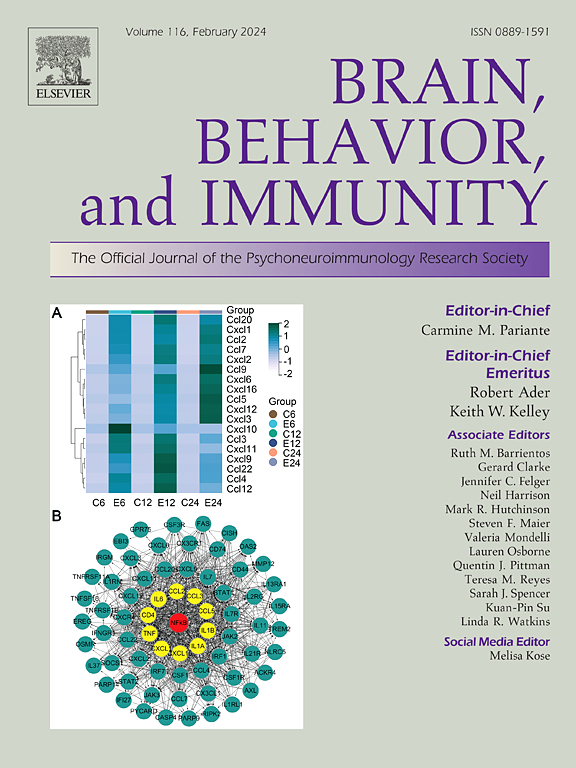Unraveling the effect of recreational fear on inflammation: A prospective cohort field study
IF 8.8
2区 医学
Q1 IMMUNOLOGY
引用次数: 0
Abstract
A fear reaction is fundamental for survival and naturally activates the adrenergic system, prompting an acute and vital flight-or-fight response. While sustained stress is associated with unhealthy low-grade inflammation, more acute and transient activation of the adrenergic system has been suggested to impact the immune system and subsequently attenuate low-grade inflammation, e.g. through cold exposure or hyperventilation. Voluntary exposure to frightening stimuli, such as scary entertainment, is another reliable activator of the adrenergic system, yet its impact on the immune system and low-grade inflammation is unknown.
The objectives of this study are to i. assess proportional changes of participants with low-grade inflammation at and three days after a voluntary frightening event, and ii. explore mean value alterations in inflammatory markers and immune cells over time.
We recruited adult participants among visitors to a real-life intense frightening haunted house attraction, located in Vejle, Denmark. The overall fright potential of the exposure was estimated through heart rate (HR) monitoring and self-reported levels of fear. Low-grade inflammation (defined as high sensitive C-reactive protein (hs-CRP) > 3 mg/L)) and immune cells (subtypes of leukocytes) were measured from blood samples immediately before, immediately after, and three days after the haunted house event.
A total of 113 participants, 69 females (61.1 %), and 44 males (38.9 %), with a mean age of 29.7 (SD 10.1) were included in the analyses. The average duration of exposure was 50 min and 51 s, while the mean HR throughout the event was 111.1 BPM (mean SD 10.1), and the mean subjective reported scare level was 5.4 (SD 1.9) on a Likert scale ranging from 1 to 9. Twenty-two participants exhibited low-grade inflammation (hs-CRP > 3 mg/L) at the event, with 10 participants normalizing their hs-CRP levels three days post-event. Seven participants had normal hs-CRP levels at the event, but low-grade inflammation three days post-event. Thus, we found no proportional difference between participants with low-grade inflammation at the event (19.5 %) and three days after the event (16.8 %) (diff. −2.7 %; 95 % CI: −10.7 to 5.4, p = 0.47). For the 22 participants exhibiting low-grade inflammation at the event, 18 participants (82 %) decreased their hs-CRP levels, with a mean decrease in hs-CRP from 5.7 mg/L pre-event to 3.7 mg/L three days post-event (diff. −2.0, 95 % CI: −3.2 to −0.7, p = 0.003). Supporting an overall attenuation of inflammation, total leukocytes and lymphocytes decreased for both participants with low-grade inflammation and with normal inflammatory levels, when comparing levels pre- and three days post-event, although all mean levels remained within the normal range.
Conclusively, we find no proportional differences in participants exhibiting low-grade inflammation (hs-CRP > 3) when comparing levels at and three days after exposure to a voluntary frightening event. However, explorative analyses suggest that recreational fear exposure may attenuate immune cells across the entire cohort (N = 113) and decrease hs-CRP levels for participants who exhibit low-grade inflammation at the event (N = 22).
揭示娱乐性恐惧对炎症的影响:前瞻性队列实地研究
恐惧反应是生存的基本要素,它自然会激活肾上腺素能系统,引发急性和重要的 "逃跑或战斗 "反应。虽然持续的压力与不健康的低度炎症有关,但更急性和短暂的肾上腺素能系统激活被认为会影响免疫系统,进而减轻低度炎症,例如通过暴露于寒冷环境或过度换气。自愿暴露于恐怖刺激(如恐怖娱乐)是肾上腺素能系统的另一种可靠激活剂,但其对免疫系统和低度炎症的影响尚不清楚。本研究的目的是:i. 评估参与者在自愿性惊吓事件发生时和发生后三天内低度炎症的比例变化;ii. 探索炎症标志物和免疫细胞随时间推移的平均值变化。我们在丹麦韦勒一个真实的恐怖鬼屋景点的游客中招募了成年参与者。我们通过心率(HR)监测和自我报告的恐惧程度来估算所暴露的整体恐惧潜能。在鬼屋活动之前、之后和三天后,分别对血液样本中的低度炎症(定义为高敏 C 反应蛋白 (hs-CRP) > 3 mg/L)和免疫细胞(白细胞亚型)进行了测量。共有 113 名参与者参与了分析,其中女性 69 人(61.1%),男性 44 人(38.9%),平均年龄 29.7 岁(标准偏差 10.1)。暴露的平均持续时间为 50 分钟 51 秒,整个过程中的平均心率为 111.1 BPM(平均 SD 10.1),主观报告的平均恐慌程度为 5.4(SD 1.9)(李克特量表的范围为 1 到 9)。22 名参与者在活动中表现出低度炎症(hs-CRP > 3 mg/L),其中 10 名参与者的 hs-CRP 水平在活动后三天恢复正常。七名参与者在活动中的 hs-CRP 水平正常,但在活动后三天出现了低度炎症。因此,我们发现活动时(19.5%)和活动后三天(16.8%)出现低度炎症的参与者之间没有比例差异(差值:-2.7%;95 % CI:-10.7 至 5.4,p = 0.47)。在活动期间表现出低度炎症的 22 名参与者中,18 名参与者(82%)的 hs-CRP 水平有所下降,hs-CRP 平均值从活动前的 5.7 毫克/升降至活动后三天的 3.7 毫克/升(差值-2.0,95 % CI:-3.2 至-0.7,p = 0.003)。与活动前和活动后三天的水平相比,低度炎症参与者和炎症水平正常的参与者的白细胞和淋巴细胞总数均有所下降,但所有平均水平均保持在正常范围内,这表明炎症总体上有所减轻。最后,我们发现,在比较自愿性惊吓事件发生时和发生后三天的水平时,表现出低度炎症(hs-CRP > 3)的参与者没有比例差异。然而,探索性分析表明,娱乐性恐惧暴露可能会削弱整个群体(N = 113)的免疫细胞,并降低在事件发生时表现出低度炎症的参与者(N = 22)的 hs-CRP 水平。
本文章由计算机程序翻译,如有差异,请以英文原文为准。
求助全文
约1分钟内获得全文
求助全文
来源期刊
CiteScore
29.60
自引率
2.00%
发文量
290
审稿时长
28 days
期刊介绍:
Established in 1987, Brain, Behavior, and Immunity proudly serves as the official journal of the Psychoneuroimmunology Research Society (PNIRS). This pioneering journal is dedicated to publishing peer-reviewed basic, experimental, and clinical studies that explore the intricate interactions among behavioral, neural, endocrine, and immune systems in both humans and animals.
As an international and interdisciplinary platform, Brain, Behavior, and Immunity focuses on original research spanning neuroscience, immunology, integrative physiology, behavioral biology, psychiatry, psychology, and clinical medicine. The journal is inclusive of research conducted at various levels, including molecular, cellular, social, and whole organism perspectives. With a commitment to efficiency, the journal facilitates online submission and review, ensuring timely publication of experimental results. Manuscripts typically undergo peer review and are returned to authors within 30 days of submission. It's worth noting that Brain, Behavior, and Immunity, published eight times a year, does not impose submission fees or page charges, fostering an open and accessible platform for scientific discourse.

 求助内容:
求助内容: 应助结果提醒方式:
应助结果提醒方式:


